In this comprehensive guide, we’ll explore everything you need to know about cavity sliding doors – from their space-saving benefits and versatile applications to installation considerations and design options available in the Australian market. Whether you’re renovating, building, or simply looking to upgrade your interior doors, this article will help you make informed decisions about incorporating these innovative space-saving solutions into your home.
Why Choose Cavity Sliding Doors for Your Home?
Cavity sliding doors have become increasingly popular in Australian homes for numerous practical and aesthetic reasons. Their innovative design offers significant advantages over traditional hinged doors and even standard sliding doors, making them an excellent investment for both new builds and renovations.
Maximized Floor Space
The most significant advantage of cavity sliding doors is their remarkable space efficiency. Unlike hinged doors that require clearance space to swing open, or standard sliding doors that slide in front of a wall, cavity sliding doors disappear completely into a wall pocket when opened. This clever design can save up to 10 square feet of floor space per door – valuable real estate in Australian homes where space comes at a premium. For apartments, compact homes, or any room where space optimization is essential, cavity sliding doors provide an elegant solution.
Versatile Room Dividers
Cavity sliding doors excel as flexible room dividers, allowing you to transform your living spaces as needed. When closed, they create distinct, private areas; when opened, they reveal an expansive, open-plan environment. This versatility is particularly valuable in contemporary Australian homes that embrace fluid living spaces. Whether separating a home office from a living area, creating a temporary guest room, or dividing kitchen and dining spaces, internal cavity sliding doors offer the perfect balance between open-concept living and practical privacy.
Clean Architectural Lines
From a design perspective, cavity sliding doors contribute to cleaner architectural lines and uncluttered spaces. When open, they create a seamless flow between rooms without the visual interruption of a door or door frame. This sleek aesthetic complements modern Australian interior design trends that favor minimalism and open spaces. Even when closed, their flush profile maintains a streamlined appearance that enhances your home’s visual appeal while providing the functionality of a traditional door.
Improved Accessibility
For homes where accessibility is a consideration, cavity sliding doors offer significant advantages. Their operation requires minimal physical effort compared to hinged doors, making them ideal for people with mobility challenges. The absence of a protruding door swing also creates safer passageways, reducing the risk of collisions in high-traffic areas. Additionally, cavity sliding doors can be designed with wider openings to accommodate wheelchairs or mobility aids without requiring the extensive clearance space that a hinged door would need.
Enhanced Natural Light
When designed with glass panels, sliding doors cavity systems allow natural light to flow freely between spaces even when closed. This feature is particularly valuable in Australian homes where maximizing natural illumination reduces energy costs and creates a more inviting atmosphere. Glass sliding doors within cavity systems create visual connections between rooms while maintaining acoustic separation when needed. For homes with limited windows or dark interior spaces, glass cavity sliding doors can dramatically improve light distribution throughout the property.
Noise Reduction
Modern cavity sliding doors offer impressive acoustic performance when properly specified. The pocket wall construction can incorporate insulation materials that enhance soundproofing between rooms. This makes cavity sliding doors an excellent choice for home offices, media rooms, or bedrooms where noise control is essential. Unlike some bifold sliding doors that may have gaps between panels, a quality cavity sliding door creates a solid barrier when closed, effectively minimizing sound transmission while maintaining a sleek appearance.
Ready to maximize your living space with elegant cavity sliding doors?
Discover how BrightView Aluminium’s custom cavity sliding door solutions can enhance your home’s functionality while adding contemporary style.
Types of Cavity Sliding Door Systems
The Australian market offers several cavity sliding door configurations to suit different architectural styles, space requirements, and functional needs. Understanding the various options will help you select the perfect solution for your home.
Single Cavity Sliding Doors
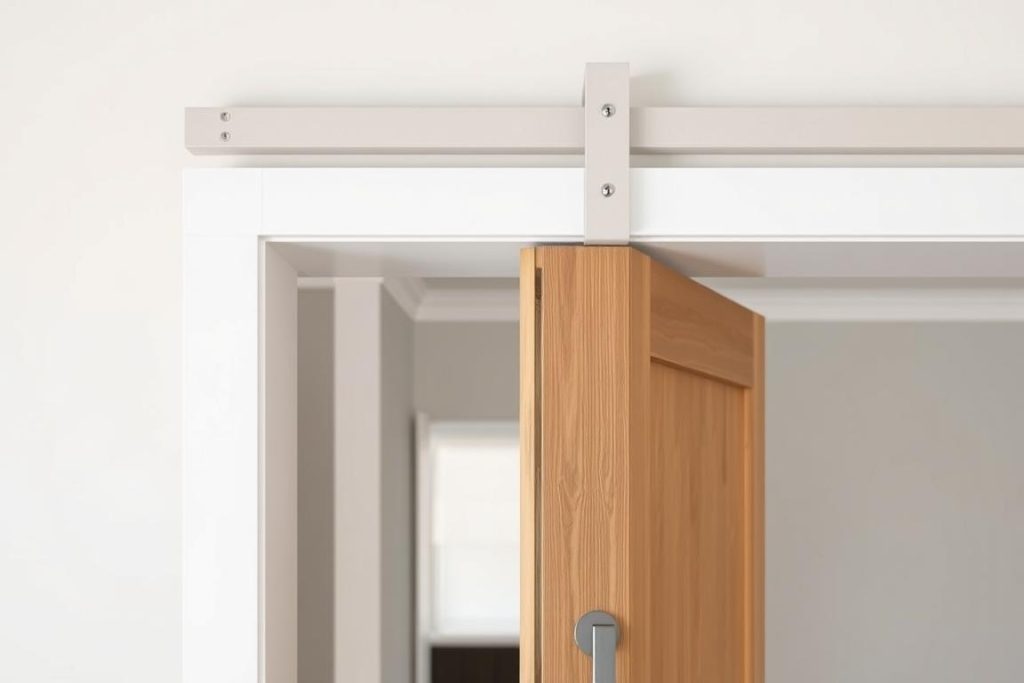
Single cavity sliding doors are the most common configuration found in Australian homes. These systems feature a single door panel that slides horizontally into a wall cavity. They offer excellent space efficiency while providing a substantial opening for access between rooms.
Key Features:
- Space-saving design ideal for bedrooms, bathrooms, and home offices
- Available in various materials including timber, glass, and aluminum
- Compatible with standard wall thicknesses (90mm stud walls)
- Smooth-rolling operation on quality track systems
- Options for soft-close mechanisms for quiet operation
Considerations:
- Requires proper wall cavity construction or retrofitting
- Wall cavity must be free of electrical wiring and plumbing
- Standard systems available from suppliers like Bunnings
- Premium systems offer enhanced features and finishes
Double Cavity Sliding Doors
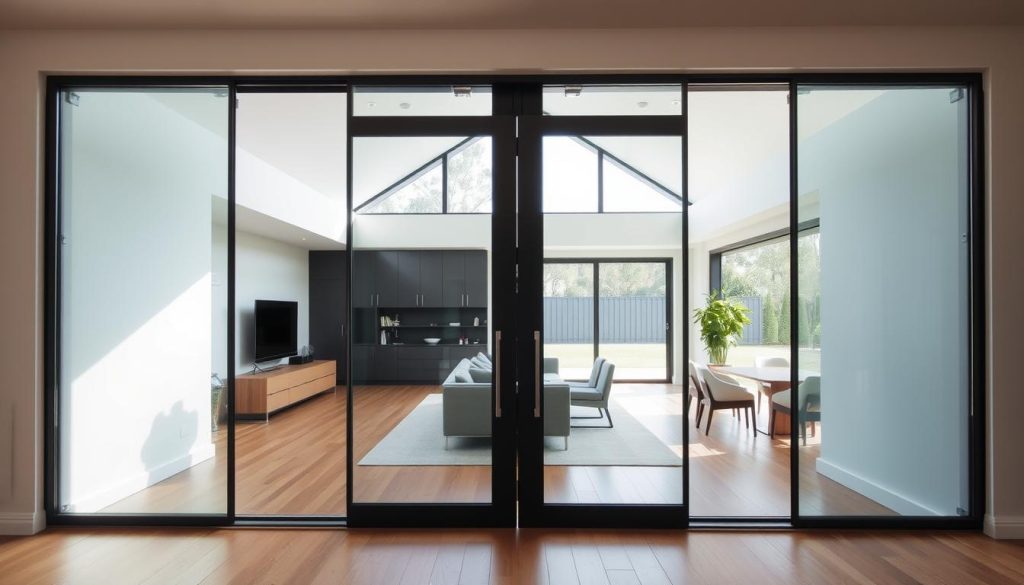
For larger openings between rooms, double cavity sliding doors provide an elegant solution. These systems feature two door panels that slide into opposite wall cavities, creating a wide, unobstructed opening that’s perfect for connecting living spaces.
Key Features:
- Creates wider openings up to 2.4 meters or more
- Perfect for connecting living and dining areas
- Available with synchronized closing mechanisms
- Options for matching or contrasting door designs
- Can incorporate glass panels for light transmission
Considerations:
- Requires cavities in walls on both sides of the opening
- More complex installation than single cavity systems
- Higher cost due to additional hardware and materials
- Structural considerations for wider openings
Glass Cavity Sliding Doors
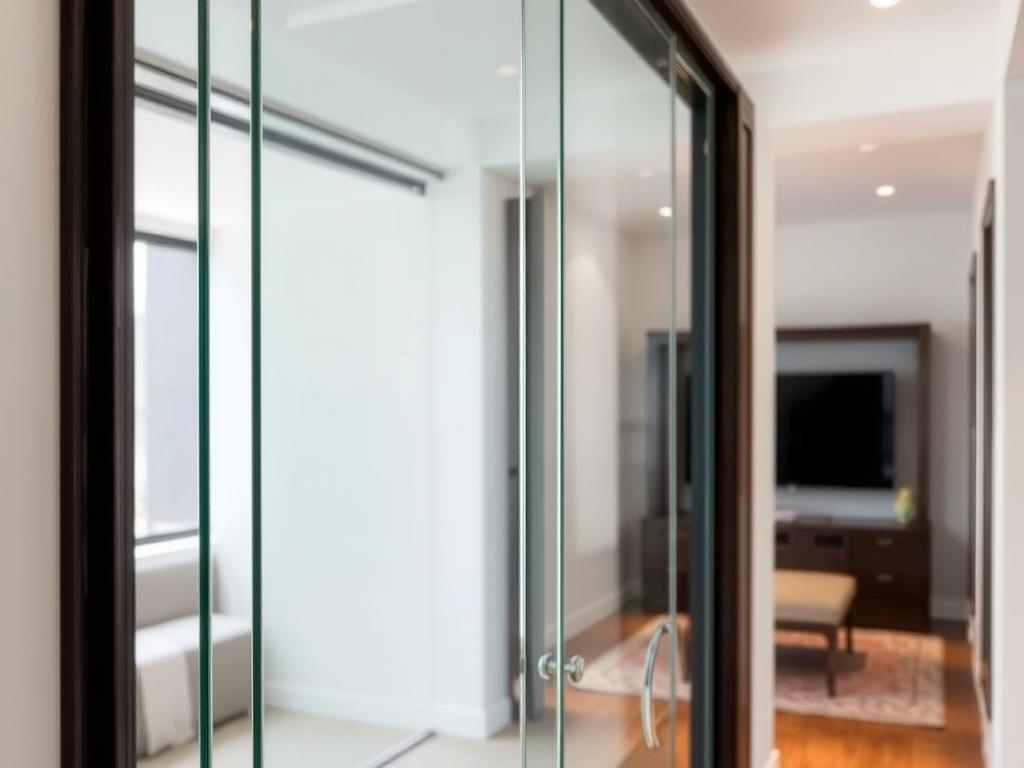
For homeowners seeking to maintain visual connections between spaces while providing acoustic separation, glass cavity sliding doors offer the perfect solution. These sophisticated systems combine the space-saving benefits of cavity doors with the light-transmitting properties of glass.
Key Features:
- Maximizes natural light transmission between rooms
- Available in framed or frameless configurations
- Options for clear, frosted, or patterned glass
- Sophisticated rolling systems for smooth operation
- Compatible with security glass for enhanced safety
Considerations:
- Premium price point reflecting specialized materials
- Requires precision installation by experienced professionals
- Heavier than timber doors, requiring robust track systems
- May require more frequent cleaning to maintain appearance
Not sure which cavity sliding door system is right for your home?
BrightView Aluminium specializes in custom sliding door solutions tailored to your specific architectural requirements and lifestyle needs.
Security and Privacy Features for Cavity Sliding Doors
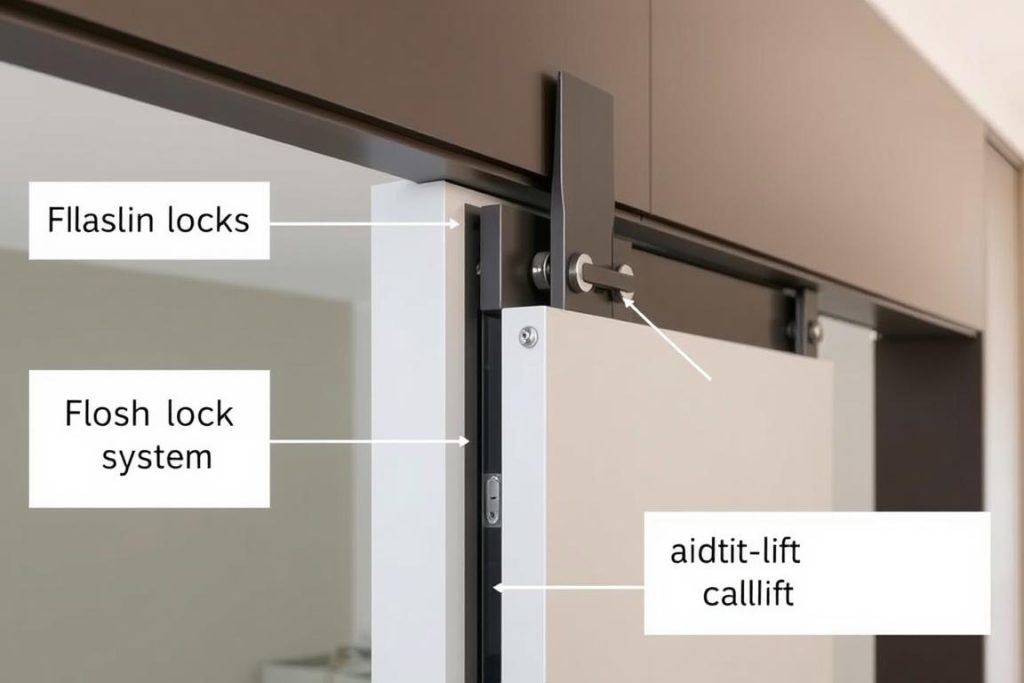
While cavity sliding doors are primarily chosen for their space-saving benefits and aesthetic appeal, modern systems incorporate several advanced security and privacy features that provide peace of mind without compromising on design or functionality.
Locking Mechanisms
Today’s cavity sliding doors offer sophisticated locking options that ensure security while maintaining their sleek appearance:
Flush Edge Locks
Specially designed for cavity sliding doors, flush edge locks sit within the door’s edge and engage with the jamb when closed. These discreet locks for glass sliding doors and timber doors provide security without protruding hardware that would prevent the door from sliding fully into the cavity. Available in key-operated or privacy latch versions, they offer various security levels while maintaining the door’s clean lines and full functionality.
Magnetic Locking Systems
For the ultimate in minimalist design, magnetic locking systems use powerful magnets to secure cavity sliding doors when closed. These innovative systems eliminate visible hardware while providing reliable closure. Premium magnetic locks include reinforced strike plates and adjustable closing pressure to prevent unauthorized access. The absence of protruding components ensures smooth operation and allows the door to retract completely into the wall cavity.
Smart Lock Integration
For tech-savvy homeowners, smart locks designed specifically for cavity sliding doors offer convenience and enhanced security. These systems can be integrated with home automation platforms, allowing remote locking/unlocking and status monitoring. Some advanced systems include tamper alerts and customized access schedules, making them ideal for areas requiring controlled access while maintaining the sleek aesthetic of cavity sliding door systems.
Privacy Solutions
Maintaining privacy while preserving the space-saving benefits of cavity sliding doors is essential in many applications:
- Frosted or Patterned Glass: For glass sliding doors cavity systems, frosted or patterned glass provides privacy while still allowing light transmission
- Solid Core Construction: Timber cavity doors with solid core construction offer superior sound insulation for enhanced acoustic privacy
- Acoustic Seals: Specialized perimeter seals reduce sound transmission through gaps around the door
- Integrated Blinds: Some glass cavity sliding doors feature blinds integrated between glass panels for adjustable privacy
Security Tip
When selecting locks for cavity sliding doors, ensure they’re specifically designed for this application. Standard locks may prevent the door from fully retracting into the wall cavity or may not provide adequate security for the sliding mechanism.
Track and Frame Security
Beyond locks and privacy features, several elements in the door’s construction enhance security:
- Anti-Lift Mechanisms: Prevent the door from being lifted out of its tracks
- Reinforced Tracks: Heavy-duty aluminum tracks resist tampering and ensure smooth operation
- Quality Hardware: Premium door handles for sliding doors enhance both security and usability
- Robust Cavity Frames: Steel-reinforced cavity frames provide structural integrity and durability
Installation Considerations for Cavity Sliding Doors
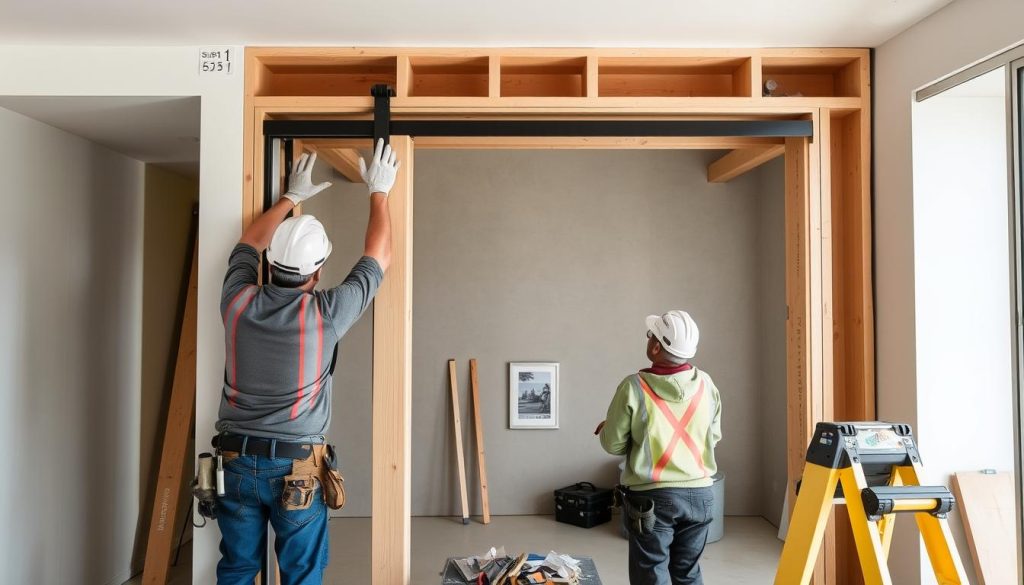
Proper installation is crucial for ensuring your cavity sliding doors perform optimally in terms of operation, durability, and appearance. Whether you’re considering a new build installation or retrofitting existing walls, understanding the process helps you make informed decisions.
Professional vs. DIY Installation
While some homeowners may consider installing cavity sliding doors themselves, there are important factors to consider when making this decision:
Professional Installation Benefits
- Ensures precise alignment for smooth operation and proper sealing
- Includes proper structural reinforcement where needed
- Guarantees correct integration with existing building elements
- Often includes warranties covering both products and workmanship
- Typically completed efficiently with minimal disruption
Professional installation is strongly recommended for cavity sliding doors, particularly for glass systems or double door configurations where precision is critical.
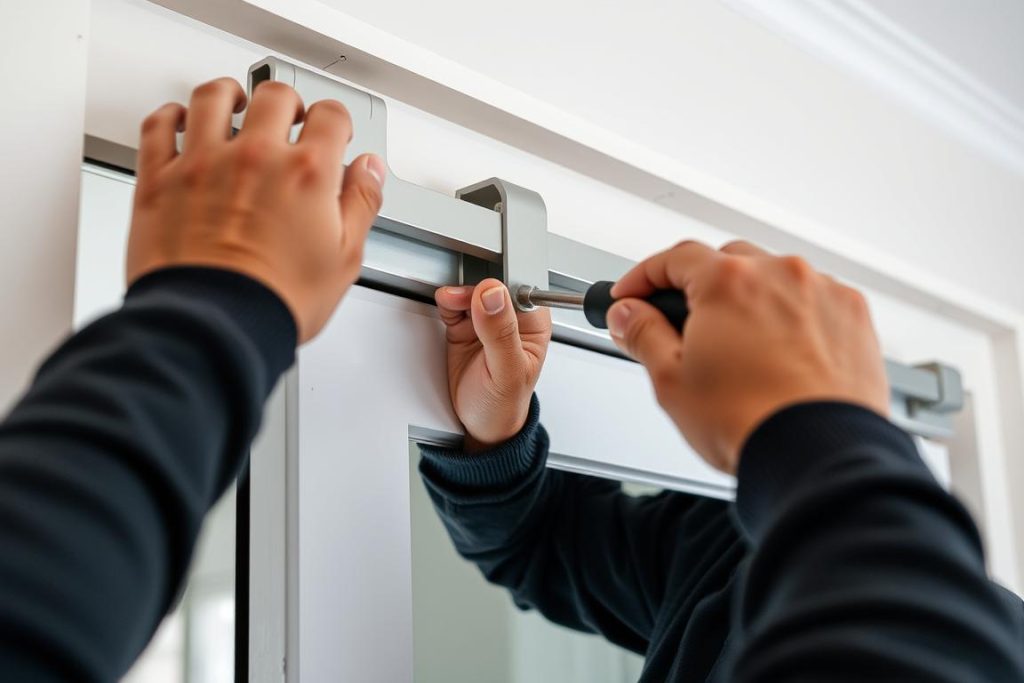
Structural Requirements
Before installation begins, several structural considerations must be addressed:
Wall Construction
Cavity sliding doors require specific wall conditions:
- Sufficient wall thickness to accommodate the door and pocket
- Typically requires minimum 90mm stud wall construction
- Wall cavity must be free of electrical wiring and plumbing
- Structural integrity must be maintained despite wall cavity
Door Weight Considerations
The weight of the door affects installation requirements:
- Heavier doors (glass or solid timber) require reinforced tracks
- Maximum door weight is typically determined by the track system
- Standard systems support doors up to 40kg
- Premium systems can support doors weighing 80kg or more
“The quality of cavity sliding door installation directly impacts longevity, operation, and appearance. Even premium door systems will underperform if installed incorrectly.”
Installation for Different Door Types
The installation approach varies significantly depending on the type of cavity sliding door system:
New Construction Installation
Installing cavity sliding doors during new construction offers the most flexibility and typically yields the best results. The process involves installing a specialized pocket frame between wall studs before wall lining is applied. This approach allows for perfect integration with the wall structure and precise alignment of all components. For new homes or major renovations, planning for cavity sliding doors from the design stage ensures optimal placement and structural support.
Retrofit Installation
Adding cavity sliding doors to existing homes requires careful planning but is entirely feasible. The process involves removing wall lining, installing the cavity pocket frame, and then reinstating and finishing the wall surfaces. While more disruptive than new construction installation, retrofit projects can be completed efficiently by experienced professionals. Many suppliers offer cavity systems specifically designed for retrofit applications, with features that simplify installation in existing walls.
Glass Door Installation
Glass sliding doors cavity systems require specialized installation techniques to ensure safe operation and proper alignment. The heavier weight of glass panels necessitates robust track systems and precise adjustment. Installation typically involves first establishing the pocket frame, then carefully installing and aligning the glass panel and hardware. Professional installation is particularly important for glass systems to ensure safety, smooth operation, and proper sealing.
Expert Installation Makes All the Difference
BrightView Aluminium offers professional measurement and installation services for cavity sliding doors, ensuring perfect operation and longevity.
Design and Aesthetic Considerations
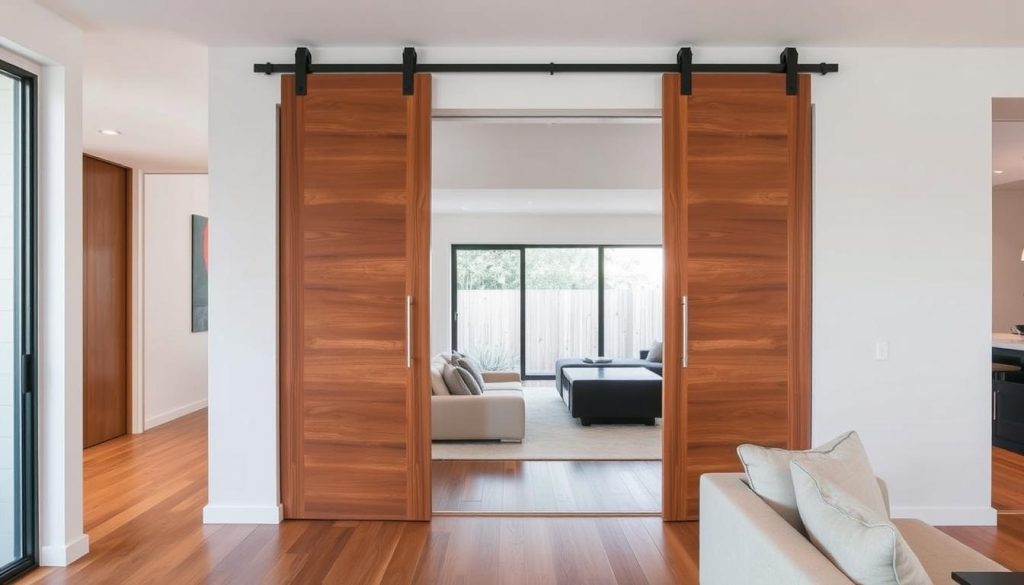
Beyond functionality, cavity sliding doors serve as a significant design element in your home. Their visual impact can define your space’s character while complementing your overall interior design scheme.
Door Materials and Finishes
The material selection for your cavity sliding door significantly influences its appearance and performance:
Timber Doors
Timber cavity sliding doors remain a popular choice in Australian homes due to their warmth and versatility. Available in various species including Tasmanian oak, maple, and jarrah, timber doors can be stained to highlight natural grain patterns or painted to match your interior color scheme. Solid timber doors offer excellent acoustic properties, while engineered timber provides enhanced stability in Australia’s variable climate conditions.
Glass Doors
Glass sliding doors within cavity systems create striking visual connections between spaces while maintaining the space-saving benefits of pocket doors. Options range from fully frameless glass to aluminum-framed panels with various glass types. Clear glass maximizes light transmission, while frosted or patterned glass provides privacy without sacrificing brightness. For contemporary Australian homes, glass cavity doors offer a sophisticated solution that enhances spatial flow.
Composite Doors
Modern composite doors combine the aesthetic appeal of timber with enhanced durability and stability. These engineered products resist warping and shrinking, making them ideal for bathroom applications or homes in coastal areas with high humidity. Available in various finishes that convincingly mimic natural timber or contemporary painted finishes, composite doors offer excellent value and performance for cavity sliding door applications.
Hardware and Accessories
The finishing touches on cavity sliding doors contribute significantly to both function and appearance:
- Flush Pulls: Recessed handles that don’t protrude, allowing the door to slide completely into the cavity
- Edge Pulls: Discreet finger pulls mounted on the door edge for minimalist appearance
- Decorative Handles: Feature handles that make a design statement while remaining functional
- Soft-Close Mechanisms: Premium hardware that gently draws the door closed, preventing slamming
- Matching Accessories: Coordinated locks, indicators, and trim for a cohesive appearance
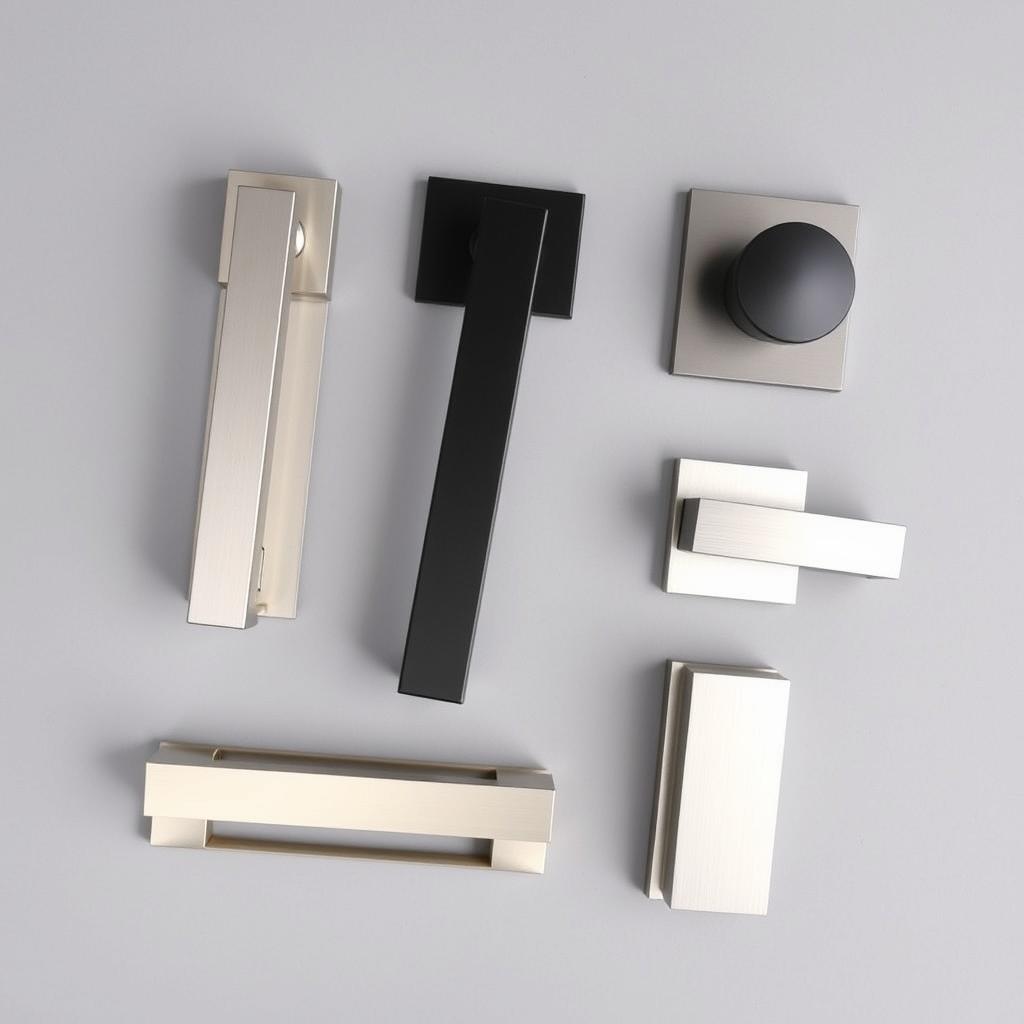
Specialized Applications
Cavity sliding doors can be adapted for various specialized uses throughout the home:
Wardrobe Sliding Doors
Wardrobe sliding doors that utilize cavity systems offer the ultimate in space efficiency for bedrooms. Unlike standard sliding wardrobe doors that remain visible when open, cavity wardrobe doors disappear completely, providing unobstructed access to the entire wardrobe space. This solution is particularly valuable in smaller bedrooms where every centimeter of floor space counts. Available in matching finishes to complement your bedroom doors, these systems create a cohesive design aesthetic.
Bathroom Applications
Cavity sliding doors are ideal for bathrooms where space is often at a premium. Water-resistant materials and finishes ensure durability in humid environments, while privacy locks provide security. For family bathrooms, cavity doors with indicator locks show occupancy status while maintaining the space-saving benefits. Some systems even incorporate integrated ventilation solutions to address moisture management while preserving the door’s sleek appearance.
Pet-Friendly Options
For pet owners, specialized sliding doors with dog door features can be incorporated into cavity systems. These innovative solutions maintain the clean lines and space efficiency of standard cavity doors while providing convenient pet access. Available in various sizes to accommodate different breeds, these integrated pet doors eliminate the need for separate pet entrances that might compromise your home’s aesthetic appeal or security.
Complementary Elements
Several design elements can enhance the impact of your cavity sliding doors:
To maximize the aesthetic impact of your cavity sliding doors, consider:
- Coordinating door styles throughout your home for visual consistency
- Matching architraves and trim to create a cohesive look
- Using consistent hardware finishes across all doors and cabinetry
- Considering bifold sliding doors for closets to complement cavity doors
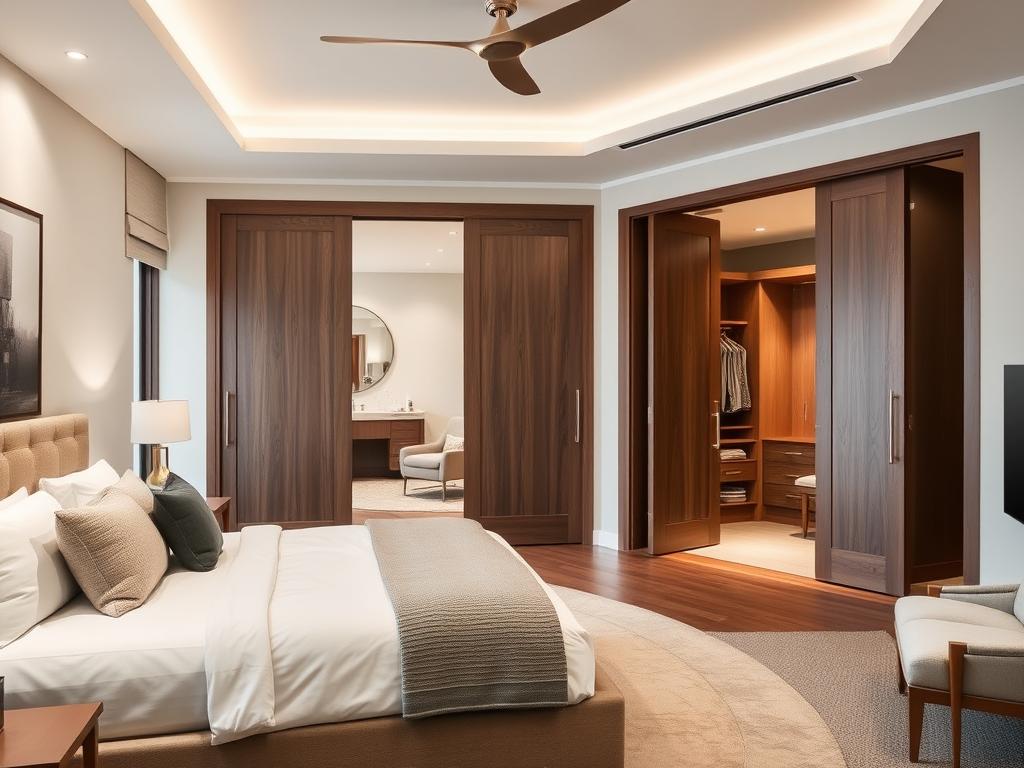
Maintenance and Care for Cavity Sliding Doors

Proper maintenance ensures your cavity sliding doors continue to operate smoothly while maintaining their appearance and functionality. Establishing a regular care routine extends the lifespan of both the door system and its components.
Routine Cleaning
Regular cleaning prevents dirt buildup that can affect both appearance and function:
Door Surface Maintenance
- Clean timber doors with appropriate wood cleaners based on finish
- Use quality glass cleaner for glass sliding doors cavity systems
- Wipe composite doors with mild soapy water and soft cloth
- Address fingerprints and smudges promptly for easiest removal
Track Cleaning
- Vacuum tracks regularly to remove debris and dust
- Use a narrow attachment to reach into track channels
- Wipe with a damp cloth to remove finer particles
- Apply silicone-based lubricant sparingly to ensure smooth operation
Periodic Maintenance
Perform these checks at least twice yearly to ensure optimal performance:
Hardware Inspection
Examine all door hardware including handles, locks, and rollers for signs of wear or loosening. Tighten any loose screws and lubricate moving parts with an appropriate product. For locks for glass sliding doors or timber cavity doors, ensure smooth operation and address any stiffness immediately to prevent mechanism damage. Replace worn components promptly to maintain security and functionality.
Track Assessment
Inspect the overhead track for any signs of damage, misalignment, or excessive wear. Check that the track is securely fastened to the header and that all mounting screws are tight. For cavity systems, ensure the track remains properly aligned with the pocket frame. Address any track issues promptly, as they can lead to door operation problems and potential damage to the door panel.
Door Alignment Check
Verify that the door maintains proper alignment within the opening and slides smoothly into the cavity. Check for any signs of binding or resistance during operation. Most cavity sliding door systems include adjustment mechanisms that allow fine-tuning of the door’s height and plumbness. Making minor adjustments when needed prevents more significant problems from developing.
Troubleshooting Common Issues
Address these common problems promptly to maintain functionality:
Door Doesn’t Slide Smoothly
If your cavity sliding door becomes difficult to move:
- Clean tracks thoroughly to remove all debris
- Check rollers for damage and replace if necessary
- Verify the door hasn’t warped or swollen due to moisture
- Adjust roller height if the door is dragging
- Apply appropriate lubricant to rollers and tracks
Door Won’t Stay Closed
If your cavity sliding door drifts open after closing:
- Check that the floor is level where the door closes
- Verify that the jamb is properly aligned
- Inspect the closing mechanism or magnetic catch
- Consider installing a flush bolt or improved latch
- Adjust the track angle slightly to create a natural “closed” position
Door Doesn’t Fully Retract
If the door doesn’t fully disappear into the cavity:
- Check for obstructions within the cavity pocket
- Verify that handle or edge pull doesn’t protrude too far
- Ensure the cavity width is appropriate for the door thickness
- Check for any warping or swelling of the door panel
- Inspect the back stop position within the cavity
Maintenance Warning
Never use WD-40 or oil-based lubricants on cavity sliding door tracks or rollers. These products attract dust and dirt, eventually making the problem worse. Instead, use dry silicone spray or specific track lubricants recommended by door manufacturers.
Conclusion: Transforming Your Space with Cavity Sliding Doors
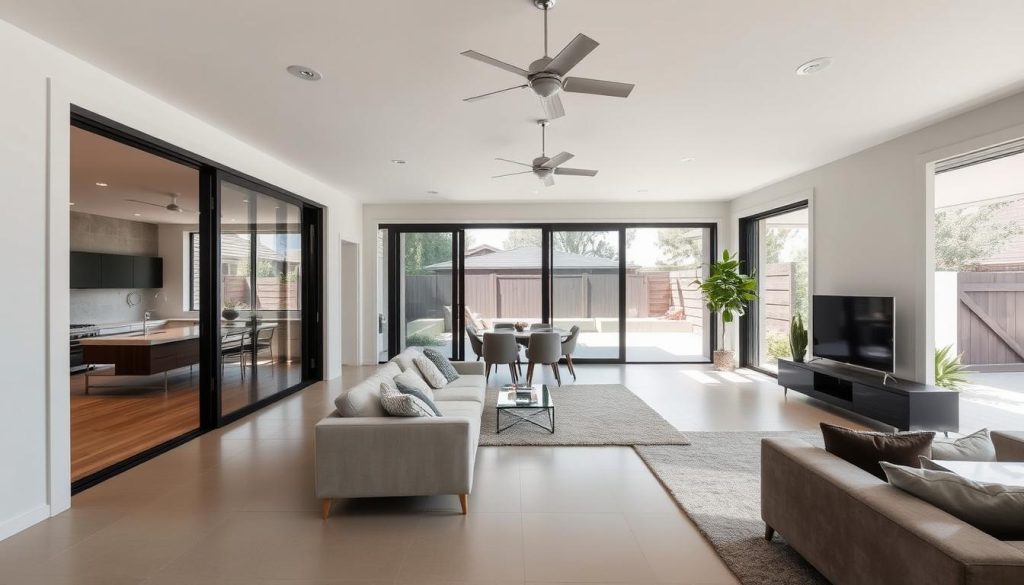
Cavity sliding doors represent one of the most impactful home improvements available to Australian homeowners. By maximizing usable floor space while providing flexible room division, these innovative door systems transform both the functionality and aesthetics of your home.
Key Considerations for Your Project
Quality Investment
While budget considerations are important, investing in quality components pays significant dividends in performance, durability, and satisfaction. Premium cavity sliding door systems offer superior operation, enhanced security, and more attractive aesthetics. Consider the long-term value rather than focusing solely on initial cost when selecting your door system, whether from specialized suppliers or sliding doors Bunnings options for more standard applications.
Professional Installation
Even the highest quality cavity sliding doors will underperform if improperly installed. Professional installation ensures correct alignment, proper cavity construction, and optimal operation. For specialized systems like glass sliding doors or double door configurations, expert installation is particularly crucial to achieving the desired results and longevity. The investment in professional installation typically pays for itself in improved performance and durability.
Customization Options
Today’s market offers unprecedented customization possibilities for cavity sliding doors. From material selection and finishes to hardware styles and integrated technologies, you can create a solution perfectly tailored to your home’s architecture and your personal preferences. Don’t settle for standard options when customized solutions can better address your specific needs and aesthetic preferences.
The Transformative Impact
The installation of cavity sliding doors delivers multiple benefits that enhance your daily living experience:
- Maximized Floor Space: By eliminating the swing arc of traditional doors, cavity sliding doors free up valuable floor space that can be used for furniture placement or circulation.
- Enhanced Accessibility: The wider, unobstructed openings created by cavity sliding doors improve access for everyone, including those with mobility challenges.
- Improved Property Value: Quality cavity sliding door installations represent an investment that typically delivers excellent returns through increased property appeal and market value.
- Design Flexibility: The ability to open up or divide spaces as needed provides unprecedented flexibility in how you use your home’s rooms and areas.
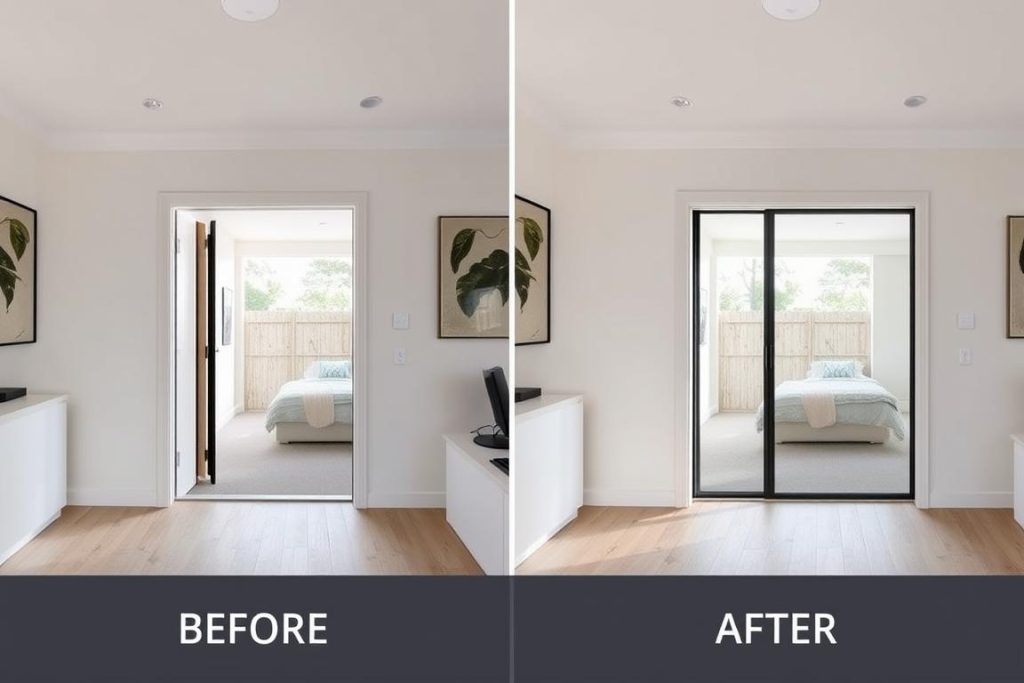
Ready to Transform Your Home with Space-Saving Cavity Sliding Doors?
BrightView Aluminium specializes in custom sliding door solutions that perfectly balance style, functionality, and space efficiency for Australian homes.
Frequently Asked Questions About Cavity Sliding Doors
How much do cavity sliding doors cost in Australia?
How much do cavity sliding doors cost in Australia?
Frequently Asked Questions About Cavity Sliding Doors
How much do cavity sliding doors cost in Australia?
Cavity sliding door costs in Australia vary based on size, materials, and features. Basic cavity systems from Bunnings or similar retailers typically range from 0-0 for the frame kit alone. Standard timber door packages including frame and hardware cost between 0-
Frequently Asked Questions About Cavity Sliding Doors
How much do cavity sliding doors cost in Australia?
Cavity sliding door costs in Australia vary based on size, materials, and features. Basic cavity systems from Bunnings or similar retailers typically range from $300-$800 for the frame kit alone. Standard timber door packages including frame and hardware cost between $600-$1,500 installed. Premium systems with glass doors or specialized features range from $1,500-$4,000+. Custom solutions with designer finishes or oversized dimensions can exceed $5,000. For accurate pricing, request quotes from multiple suppliers based on your specific requirements.
Can cavity sliding doors be installed in existing walls?
Yes, cavity sliding doors can be retrofitted into existing walls, though the process is more involved than installation during new construction. The retrofit process requires removing wall lining on at least one side, installing the cavity pocket frame, and then reinstating and finishing the wall surfaces. The wall must be non-load-bearing or properly reinforced, and free of electrical wiring, plumbing, or other obstacles that cannot be relocated. While more disruptive than new construction installation, experienced professionals can complete retrofit installations efficiently with minimal structural modification.
How do cavity sliding doors compare to bifold sliding doors?
Cavity sliding doors and bifold sliding doors serve similar purposes but operate differently. Cavity doors slide completely into the wall, disappearing from view when open and requiring wall cavity construction. Bifold doors fold accordion-style against the wall, remaining partially visible when open but not requiring wall modification. Cavity doors typically offer cleaner aesthetics when open and take up no visible space, while bifold doors are often easier to retrofit and may be more suitable for wider openings where cavity construction isn’t practical.
Can I add a pet door to a cavity sliding door?
Yes, sliding doors with dog door features can be incorporated into cavity systems, though with some limitations. The pet door must be positioned to remain accessible when the door is both open and closed, typically near the edge that remains visible when the door is partially open. Custom solutions are available that maintain the door’s ability to slide fully into the cavity while providing pet access. These specialized systems work best when planned during initial installation rather than retrofitted to existing cavity doors.
Are cavity sliding doors suitable for bathrooms?
Cavity sliding doors are excellent for bathrooms, particularly in smaller spaces where door swing area is limited. For bathroom applications, select moisture-resistant door materials such as composite doors, properly sealed timber, or glass. Ensure the hardware is corrosion-resistant and consider privacy locks designed specifically for cavity doors. Some manufacturers offer complete bathroom-ready cavity door systems with appropriate seals to manage moisture and provide acoustic privacy. With proper material selection and installation, cavity sliding doors perform exceptionally well in bathroom environments.
What’s the difference between internal cavity sliding doors and external sliding doors?
Internal cavity sliding doors are designed for interior applications, sliding into a wall pocket with focus on space efficiency and aesthetics. External sliding doors (like patio doors) typically slide along a track outside the wall plane and are engineered for weather resistance, security, and thermal performance. External doors generally have more robust frames, weather sealing, and security features. While some external doors use cavity systems (particularly in high-end homes), most use exposed track systems where the door remains visible when open, sliding past a fixed panel or adjacent wall.
,500 installed. Premium systems with glass doors or specialized features range from
Frequently Asked Questions About Cavity Sliding Doors
How much do cavity sliding doors cost in Australia?
Cavity sliding door costs in Australia vary based on size, materials, and features. Basic cavity systems from Bunnings or similar retailers typically range from $300-$800 for the frame kit alone. Standard timber door packages including frame and hardware cost between $600-$1,500 installed. Premium systems with glass doors or specialized features range from $1,500-$4,000+. Custom solutions with designer finishes or oversized dimensions can exceed $5,000. For accurate pricing, request quotes from multiple suppliers based on your specific requirements.
Can cavity sliding doors be installed in existing walls?
Yes, cavity sliding doors can be retrofitted into existing walls, though the process is more involved than installation during new construction. The retrofit process requires removing wall lining on at least one side, installing the cavity pocket frame, and then reinstating and finishing the wall surfaces. The wall must be non-load-bearing or properly reinforced, and free of electrical wiring, plumbing, or other obstacles that cannot be relocated. While more disruptive than new construction installation, experienced professionals can complete retrofit installations efficiently with minimal structural modification.
How do cavity sliding doors compare to bifold sliding doors?
Cavity sliding doors and bifold sliding doors serve similar purposes but operate differently. Cavity doors slide completely into the wall, disappearing from view when open and requiring wall cavity construction. Bifold doors fold accordion-style against the wall, remaining partially visible when open but not requiring wall modification. Cavity doors typically offer cleaner aesthetics when open and take up no visible space, while bifold doors are often easier to retrofit and may be more suitable for wider openings where cavity construction isn’t practical.
Can I add a pet door to a cavity sliding door?
Yes, sliding doors with dog door features can be incorporated into cavity systems, though with some limitations. The pet door must be positioned to remain accessible when the door is both open and closed, typically near the edge that remains visible when the door is partially open. Custom solutions are available that maintain the door’s ability to slide fully into the cavity while providing pet access. These specialized systems work best when planned during initial installation rather than retrofitted to existing cavity doors.
Are cavity sliding doors suitable for bathrooms?
Cavity sliding doors are excellent for bathrooms, particularly in smaller spaces where door swing area is limited. For bathroom applications, select moisture-resistant door materials such as composite doors, properly sealed timber, or glass. Ensure the hardware is corrosion-resistant and consider privacy locks designed specifically for cavity doors. Some manufacturers offer complete bathroom-ready cavity door systems with appropriate seals to manage moisture and provide acoustic privacy. With proper material selection and installation, cavity sliding doors perform exceptionally well in bathroom environments.
What’s the difference between internal cavity sliding doors and external sliding doors?
Internal cavity sliding doors are designed for interior applications, sliding into a wall pocket with focus on space efficiency and aesthetics. External sliding doors (like patio doors) typically slide along a track outside the wall plane and are engineered for weather resistance, security, and thermal performance. External doors generally have more robust frames, weather sealing, and security features. While some external doors use cavity systems (particularly in high-end homes), most use exposed track systems where the door remains visible when open, sliding past a fixed panel or adjacent wall.
,500-,000+. Custom solutions with designer finishes or oversized dimensions can exceed ,000. For accurate pricing, request quotes from multiple suppliers based on your specific requirements.
Can cavity sliding doors be installed in existing walls?
Yes, cavity sliding doors can be retrofitted into existing walls, though the process is more involved than installation during new construction. The retrofit process requires removing wall lining on at least one side, installing the cavity pocket frame, and then reinstating and finishing the wall surfaces. The wall must be non-load-bearing or properly reinforced, and free of electrical wiring, plumbing, or other obstacles that cannot be relocated. While more disruptive than new construction installation, experienced professionals can complete retrofit installations efficiently with minimal structural modification.
How do cavity sliding doors compare to bifold sliding doors?
Cavity sliding doors and bifold sliding doors serve similar purposes but operate differently. Cavity doors slide completely into the wall, disappearing from view when open and requiring wall cavity construction. Bifold doors fold accordion-style against the wall, remaining partially visible when open but not requiring wall modification. Cavity doors typically offer cleaner aesthetics when open and take up no visible space, while bifold doors are often easier to retrofit and may be more suitable for wider openings where cavity construction isn’t practical.
Can I add a pet door to a cavity sliding door?
Yes, sliding doors with dog door features can be incorporated into cavity systems, though with some limitations. The pet door must be positioned to remain accessible when the door is both open and closed, typically near the edge that remains visible when the door is partially open. Custom solutions are available that maintain the door’s ability to slide fully into the cavity while providing pet access. These specialized systems work best when planned during initial installation rather than retrofitted to existing cavity doors.
Are cavity sliding doors suitable for bathrooms?
Cavity sliding doors are excellent for bathrooms, particularly in smaller spaces where door swing area is limited. For bathroom applications, select moisture-resistant door materials such as composite doors, properly sealed timber, or glass. Ensure the hardware is corrosion-resistant and consider privacy locks designed specifically for cavity doors. Some manufacturers offer complete bathroom-ready cavity door systems with appropriate seals to manage moisture and provide acoustic privacy. With proper material selection and installation, cavity sliding doors perform exceptionally well in bathroom environments.
What’s the difference between internal cavity sliding doors and external sliding doors?
Internal cavity sliding doors are designed for interior applications, sliding into a wall pocket with focus on space efficiency and aesthetics. External sliding doors (like patio doors) typically slide along a track outside the wall plane and are engineered for weather resistance, security, and thermal performance. External doors generally have more robust frames, weather sealing, and security features. While some external doors use cavity systems (particularly in high-end homes), most use exposed track systems where the door remains visible when open, sliding past a fixed panel or adjacent wall.
Frequently Asked Questions About Cavity Sliding Doors
How much do cavity sliding doors cost in Australia?
Cavity sliding door costs in Australia vary based on size, materials, and features. Basic cavity systems from Bunnings or similar retailers typically range from 0-0 for the frame kit alone. Standard timber door packages including frame and hardware cost between 0-
Frequently Asked Questions About Cavity Sliding Doors
How much do cavity sliding doors cost in Australia?
Cavity sliding door costs in Australia vary based on size, materials, and features. Basic cavity systems from Bunnings or similar retailers typically range from $300-$800 for the frame kit alone. Standard timber door packages including frame and hardware cost between $600-$1,500 installed. Premium systems with glass doors or specialized features range from $1,500-$4,000+. Custom solutions with designer finishes or oversized dimensions can exceed $5,000. For accurate pricing, request quotes from multiple suppliers based on your specific requirements.
Can cavity sliding doors be installed in existing walls?
Yes, cavity sliding doors can be retrofitted into existing walls, though the process is more involved than installation during new construction. The retrofit process requires removing wall lining on at least one side, installing the cavity pocket frame, and then reinstating and finishing the wall surfaces. The wall must be non-load-bearing or properly reinforced, and free of electrical wiring, plumbing, or other obstacles that cannot be relocated. While more disruptive than new construction installation, experienced professionals can complete retrofit installations efficiently with minimal structural modification.
How do cavity sliding doors compare to bifold sliding doors?
Cavity sliding doors and bifold sliding doors serve similar purposes but operate differently. Cavity doors slide completely into the wall, disappearing from view when open and requiring wall cavity construction. Bifold doors fold accordion-style against the wall, remaining partially visible when open but not requiring wall modification. Cavity doors typically offer cleaner aesthetics when open and take up no visible space, while bifold doors are often easier to retrofit and may be more suitable for wider openings where cavity construction isn’t practical.
Can I add a pet door to a cavity sliding door?
Yes, sliding doors with dog door features can be incorporated into cavity systems, though with some limitations. The pet door must be positioned to remain accessible when the door is both open and closed, typically near the edge that remains visible when the door is partially open. Custom solutions are available that maintain the door’s ability to slide fully into the cavity while providing pet access. These specialized systems work best when planned during initial installation rather than retrofitted to existing cavity doors.
Are cavity sliding doors suitable for bathrooms?
Cavity sliding doors are excellent for bathrooms, particularly in smaller spaces where door swing area is limited. For bathroom applications, select moisture-resistant door materials such as composite doors, properly sealed timber, or glass. Ensure the hardware is corrosion-resistant and consider privacy locks designed specifically for cavity doors. Some manufacturers offer complete bathroom-ready cavity door systems with appropriate seals to manage moisture and provide acoustic privacy. With proper material selection and installation, cavity sliding doors perform exceptionally well in bathroom environments.
What’s the difference between internal cavity sliding doors and external sliding doors?
Internal cavity sliding doors are designed for interior applications, sliding into a wall pocket with focus on space efficiency and aesthetics. External sliding doors (like patio doors) typically slide along a track outside the wall plane and are engineered for weather resistance, security, and thermal performance. External doors generally have more robust frames, weather sealing, and security features. While some external doors use cavity systems (particularly in high-end homes), most use exposed track systems where the door remains visible when open, sliding past a fixed panel or adjacent wall.
,500 installed. Premium systems with glass doors or specialized features range from
Frequently Asked Questions About Cavity Sliding Doors
How much do cavity sliding doors cost in Australia?
Cavity sliding door costs in Australia vary based on size, materials, and features. Basic cavity systems from Bunnings or similar retailers typically range from $300-$800 for the frame kit alone. Standard timber door packages including frame and hardware cost between $600-$1,500 installed. Premium systems with glass doors or specialized features range from $1,500-$4,000+. Custom solutions with designer finishes or oversized dimensions can exceed $5,000. For accurate pricing, request quotes from multiple suppliers based on your specific requirements.
Can cavity sliding doors be installed in existing walls?
Yes, cavity sliding doors can be retrofitted into existing walls, though the process is more involved than installation during new construction. The retrofit process requires removing wall lining on at least one side, installing the cavity pocket frame, and then reinstating and finishing the wall surfaces. The wall must be non-load-bearing or properly reinforced, and free of electrical wiring, plumbing, or other obstacles that cannot be relocated. While more disruptive than new construction installation, experienced professionals can complete retrofit installations efficiently with minimal structural modification.
How do cavity sliding doors compare to bifold sliding doors?
Cavity sliding doors and bifold sliding doors serve similar purposes but operate differently. Cavity doors slide completely into the wall, disappearing from view when open and requiring wall cavity construction. Bifold doors fold accordion-style against the wall, remaining partially visible when open but not requiring wall modification. Cavity doors typically offer cleaner aesthetics when open and take up no visible space, while bifold doors are often easier to retrofit and may be more suitable for wider openings where cavity construction isn’t practical.
Can I add a pet door to a cavity sliding door?
Yes, sliding doors with dog door features can be incorporated into cavity systems, though with some limitations. The pet door must be positioned to remain accessible when the door is both open and closed, typically near the edge that remains visible when the door is partially open. Custom solutions are available that maintain the door’s ability to slide fully into the cavity while providing pet access. These specialized systems work best when planned during initial installation rather than retrofitted to existing cavity doors.
Are cavity sliding doors suitable for bathrooms?
Cavity sliding doors are excellent for bathrooms, particularly in smaller spaces where door swing area is limited. For bathroom applications, select moisture-resistant door materials such as composite doors, properly sealed timber, or glass. Ensure the hardware is corrosion-resistant and consider privacy locks designed specifically for cavity doors. Some manufacturers offer complete bathroom-ready cavity door systems with appropriate seals to manage moisture and provide acoustic privacy. With proper material selection and installation, cavity sliding doors perform exceptionally well in bathroom environments.
What’s the difference between internal cavity sliding doors and external sliding doors?
Internal cavity sliding doors are designed for interior applications, sliding into a wall pocket with focus on space efficiency and aesthetics. External sliding doors (like patio doors) typically slide along a track outside the wall plane and are engineered for weather resistance, security, and thermal performance. External doors generally have more robust frames, weather sealing, and security features. While some external doors use cavity systems (particularly in high-end homes), most use exposed track systems where the door remains visible when open, sliding past a fixed panel or adjacent wall.
,500-,000+. Custom solutions with designer finishes or oversized dimensions can exceed ,000. For accurate pricing, request quotes from multiple suppliers based on your specific requirements.
Can cavity sliding doors be installed in existing walls?
Yes, cavity sliding doors can be retrofitted into existing walls, though the process is more involved than installation during new construction. The retrofit process requires removing wall lining on at least one side, installing the cavity pocket frame, and then reinstating and finishing the wall surfaces. The wall must be non-load-bearing or properly reinforced, and free of electrical wiring, plumbing, or other obstacles that cannot be relocated. While more disruptive than new construction installation, experienced professionals can complete retrofit installations efficiently with minimal structural modification.
How do cavity sliding doors compare to bifold sliding doors?
Cavity sliding doors and bifold sliding doors serve similar purposes but operate differently. Cavity doors slide completely into the wall, disappearing from view when open and requiring wall cavity construction. Bifold doors fold accordion-style against the wall, remaining partially visible when open but not requiring wall modification. Cavity doors typically offer cleaner aesthetics when open and take up no visible space, while bifold doors are often easier to retrofit and may be more suitable for wider openings where cavity construction isn’t practical.
Can I add a pet door to a cavity sliding door?
Yes, sliding doors with dog door features can be incorporated into cavity systems, though with some limitations. The pet door must be positioned to remain accessible when the door is both open and closed, typically near the edge that remains visible when the door is partially open. Custom solutions are available that maintain the door’s ability to slide fully into the cavity while providing pet access. These specialized systems work best when planned during initial installation rather than retrofitted to existing cavity doors.
Are cavity sliding doors suitable for bathrooms?
Cavity sliding doors are excellent for bathrooms, particularly in smaller spaces where door swing area is limited. For bathroom applications, select moisture-resistant door materials such as composite doors, properly sealed timber, or glass. Ensure the hardware is corrosion-resistant and consider privacy locks designed specifically for cavity doors. Some manufacturers offer complete bathroom-ready cavity door systems with appropriate seals to manage moisture and provide acoustic privacy. With proper material selection and installation, cavity sliding doors perform exceptionally well in bathroom environments.
What’s the difference between internal cavity sliding doors and external sliding doors?
Internal cavity sliding doors are designed for interior applications, sliding into a wall pocket with focus on space efficiency and aesthetics. External sliding doors (like patio doors) typically slide along a track outside the wall plane and are engineered for weather resistance, security, and thermal performance. External doors generally have more robust frames, weather sealing, and security features. While some external doors use cavity systems (particularly in high-end homes), most use exposed track systems where the door remains visible when open, sliding past a fixed panel or adjacent wall.
Can cavity sliding doors be installed in existing walls?
How do cavity sliding doors compare to bifold sliding doors?
Can I add a pet door to a cavity sliding door?
Are cavity sliding doors suitable for bathrooms?
What’s the difference between internal cavity sliding doors and external sliding doors?
How much do cavity sliding doors cost in Australia?
Frequently Asked Questions About Cavity Sliding Doors
How much do cavity sliding doors cost in Australia?
Cavity sliding door costs in Australia vary based on size, materials, and features. Basic cavity systems from Bunnings or similar retailers typically range from 0-0 for the frame kit alone. Standard timber door packages including frame and hardware cost between 0-
Frequently Asked Questions About Cavity Sliding Doors
How much do cavity sliding doors cost in Australia?
Cavity sliding door costs in Australia vary based on size, materials, and features. Basic cavity systems from Bunnings or similar retailers typically range from $300-$800 for the frame kit alone. Standard timber door packages including frame and hardware cost between $600-$1,500 installed. Premium systems with glass doors or specialized features range from $1,500-$4,000+. Custom solutions with designer finishes or oversized dimensions can exceed $5,000. For accurate pricing, request quotes from multiple suppliers based on your specific requirements.
Can cavity sliding doors be installed in existing walls?
Yes, cavity sliding doors can be retrofitted into existing walls, though the process is more involved than installation during new construction. The retrofit process requires removing wall lining on at least one side, installing the cavity pocket frame, and then reinstating and finishing the wall surfaces. The wall must be non-load-bearing or properly reinforced, and free of electrical wiring, plumbing, or other obstacles that cannot be relocated. While more disruptive than new construction installation, experienced professionals can complete retrofit installations efficiently with minimal structural modification.
How do cavity sliding doors compare to bifold sliding doors?
Cavity sliding doors and bifold sliding doors serve similar purposes but operate differently. Cavity doors slide completely into the wall, disappearing from view when open and requiring wall cavity construction. Bifold doors fold accordion-style against the wall, remaining partially visible when open but not requiring wall modification. Cavity doors typically offer cleaner aesthetics when open and take up no visible space, while bifold doors are often easier to retrofit and may be more suitable for wider openings where cavity construction isn’t practical.
Can I add a pet door to a cavity sliding door?
Yes, sliding doors with dog door features can be incorporated into cavity systems, though with some limitations. The pet door must be positioned to remain accessible when the door is both open and closed, typically near the edge that remains visible when the door is partially open. Custom solutions are available that maintain the door’s ability to slide fully into the cavity while providing pet access. These specialized systems work best when planned during initial installation rather than retrofitted to existing cavity doors.
Are cavity sliding doors suitable for bathrooms?
Cavity sliding doors are excellent for bathrooms, particularly in smaller spaces where door swing area is limited. For bathroom applications, select moisture-resistant door materials such as composite doors, properly sealed timber, or glass. Ensure the hardware is corrosion-resistant and consider privacy locks designed specifically for cavity doors. Some manufacturers offer complete bathroom-ready cavity door systems with appropriate seals to manage moisture and provide acoustic privacy. With proper material selection and installation, cavity sliding doors perform exceptionally well in bathroom environments.
What’s the difference between internal cavity sliding doors and external sliding doors?
Internal cavity sliding doors are designed for interior applications, sliding into a wall pocket with focus on space efficiency and aesthetics. External sliding doors (like patio doors) typically slide along a track outside the wall plane and are engineered for weather resistance, security, and thermal performance. External doors generally have more robust frames, weather sealing, and security features. While some external doors use cavity systems (particularly in high-end homes), most use exposed track systems where the door remains visible when open, sliding past a fixed panel or adjacent wall.
,500 installed. Premium systems with glass doors or specialized features range from
Frequently Asked Questions About Cavity Sliding Doors
How much do cavity sliding doors cost in Australia?
Cavity sliding door costs in Australia vary based on size, materials, and features. Basic cavity systems from Bunnings or similar retailers typically range from $300-$800 for the frame kit alone. Standard timber door packages including frame and hardware cost between $600-$1,500 installed. Premium systems with glass doors or specialized features range from $1,500-$4,000+. Custom solutions with designer finishes or oversized dimensions can exceed $5,000. For accurate pricing, request quotes from multiple suppliers based on your specific requirements.
Can cavity sliding doors be installed in existing walls?
Yes, cavity sliding doors can be retrofitted into existing walls, though the process is more involved than installation during new construction. The retrofit process requires removing wall lining on at least one side, installing the cavity pocket frame, and then reinstating and finishing the wall surfaces. The wall must be non-load-bearing or properly reinforced, and free of electrical wiring, plumbing, or other obstacles that cannot be relocated. While more disruptive than new construction installation, experienced professionals can complete retrofit installations efficiently with minimal structural modification.
How do cavity sliding doors compare to bifold sliding doors?
Cavity sliding doors and bifold sliding doors serve similar purposes but operate differently. Cavity doors slide completely into the wall, disappearing from view when open and requiring wall cavity construction. Bifold doors fold accordion-style against the wall, remaining partially visible when open but not requiring wall modification. Cavity doors typically offer cleaner aesthetics when open and take up no visible space, while bifold doors are often easier to retrofit and may be more suitable for wider openings where cavity construction isn’t practical.
Can I add a pet door to a cavity sliding door?
Yes, sliding doors with dog door features can be incorporated into cavity systems, though with some limitations. The pet door must be positioned to remain accessible when the door is both open and closed, typically near the edge that remains visible when the door is partially open. Custom solutions are available that maintain the door’s ability to slide fully into the cavity while providing pet access. These specialized systems work best when planned during initial installation rather than retrofitted to existing cavity doors.
Are cavity sliding doors suitable for bathrooms?
Cavity sliding doors are excellent for bathrooms, particularly in smaller spaces where door swing area is limited. For bathroom applications, select moisture-resistant door materials such as composite doors, properly sealed timber, or glass. Ensure the hardware is corrosion-resistant and consider privacy locks designed specifically for cavity doors. Some manufacturers offer complete bathroom-ready cavity door systems with appropriate seals to manage moisture and provide acoustic privacy. With proper material selection and installation, cavity sliding doors perform exceptionally well in bathroom environments.
What’s the difference between internal cavity sliding doors and external sliding doors?
Internal cavity sliding doors are designed for interior applications, sliding into a wall pocket with focus on space efficiency and aesthetics. External sliding doors (like patio doors) typically slide along a track outside the wall plane and are engineered for weather resistance, security, and thermal performance. External doors generally have more robust frames, weather sealing, and security features. While some external doors use cavity systems (particularly in high-end homes), most use exposed track systems where the door remains visible when open, sliding past a fixed panel or adjacent wall.
,500-,000+. Custom solutions with designer finishes or oversized dimensions can exceed ,000. For accurate pricing, request quotes from multiple suppliers based on your specific requirements.
Can cavity sliding doors be installed in existing walls?
Yes, cavity sliding doors can be retrofitted into existing walls, though the process is more involved than installation during new construction. The retrofit process requires removing wall lining on at least one side, installing the cavity pocket frame, and then reinstating and finishing the wall surfaces. The wall must be non-load-bearing or properly reinforced, and free of electrical wiring, plumbing, or other obstacles that cannot be relocated. While more disruptive than new construction installation, experienced professionals can complete retrofit installations efficiently with minimal structural modification.
How do cavity sliding doors compare to bifold sliding doors?
Cavity sliding doors and bifold sliding doors serve similar purposes but operate differently. Cavity doors slide completely into the wall, disappearing from view when open and requiring wall cavity construction. Bifold doors fold accordion-style against the wall, remaining partially visible when open but not requiring wall modification. Cavity doors typically offer cleaner aesthetics when open and take up no visible space, while bifold doors are often easier to retrofit and may be more suitable for wider openings where cavity construction isn’t practical.
Can I add a pet door to a cavity sliding door?
Yes, sliding doors with dog door features can be incorporated into cavity systems, though with some limitations. The pet door must be positioned to remain accessible when the door is both open and closed, typically near the edge that remains visible when the door is partially open. Custom solutions are available that maintain the door’s ability to slide fully into the cavity while providing pet access. These specialized systems work best when planned during initial installation rather than retrofitted to existing cavity doors.
Are cavity sliding doors suitable for bathrooms?
Cavity sliding doors are excellent for bathrooms, particularly in smaller spaces where door swing area is limited. For bathroom applications, select moisture-resistant door materials such as composite doors, properly sealed timber, or glass. Ensure the hardware is corrosion-resistant and consider privacy locks designed specifically for cavity doors. Some manufacturers offer complete bathroom-ready cavity door systems with appropriate seals to manage moisture and provide acoustic privacy. With proper material selection and installation, cavity sliding doors perform exceptionally well in bathroom environments.
What’s the difference between internal cavity sliding doors and external sliding doors?
Internal cavity sliding doors are designed for interior applications, sliding into a wall pocket with focus on space efficiency and aesthetics. External sliding doors (like patio doors) typically slide along a track outside the wall plane and are engineered for weather resistance, security, and thermal performance. External doors generally have more robust frames, weather sealing, and security features. While some external doors use cavity systems (particularly in high-end homes), most use exposed track systems where the door remains visible when open, sliding past a fixed panel or adjacent wall.
Frequently Asked Questions About Cavity Sliding Doors
How much do cavity sliding doors cost in Australia?
Cavity sliding door costs in Australia vary based on size, materials, and features. Basic cavity systems from Bunnings or similar retailers typically range from 0-0 for the frame kit alone. Standard timber door packages including frame and hardware cost between 0-
Frequently Asked Questions About Cavity Sliding Doors
How much do cavity sliding doors cost in Australia?
Cavity sliding door costs in Australia vary based on size, materials, and features. Basic cavity systems from Bunnings or similar retailers typically range from $300-$800 for the frame kit alone. Standard timber door packages including frame and hardware cost between $600-$1,500 installed. Premium systems with glass doors or specialized features range from $1,500-$4,000+. Custom solutions with designer finishes or oversized dimensions can exceed $5,000. For accurate pricing, request quotes from multiple suppliers based on your specific requirements.
Can cavity sliding doors be installed in existing walls?
Yes, cavity sliding doors can be retrofitted into existing walls, though the process is more involved than installation during new construction. The retrofit process requires removing wall lining on at least one side, installing the cavity pocket frame, and then reinstating and finishing the wall surfaces. The wall must be non-load-bearing or properly reinforced, and free of electrical wiring, plumbing, or other obstacles that cannot be relocated. While more disruptive than new construction installation, experienced professionals can complete retrofit installations efficiently with minimal structural modification.
How do cavity sliding doors compare to bifold sliding doors?
Cavity sliding doors and bifold sliding doors serve similar purposes but operate differently. Cavity doors slide completely into the wall, disappearing from view when open and requiring wall cavity construction. Bifold doors fold accordion-style against the wall, remaining partially visible when open but not requiring wall modification. Cavity doors typically offer cleaner aesthetics when open and take up no visible space, while bifold doors are often easier to retrofit and may be more suitable for wider openings where cavity construction isn’t practical.
Can I add a pet door to a cavity sliding door?
Yes, sliding doors with dog door features can be incorporated into cavity systems, though with some limitations. The pet door must be positioned to remain accessible when the door is both open and closed, typically near the edge that remains visible when the door is partially open. Custom solutions are available that maintain the door’s ability to slide fully into the cavity while providing pet access. These specialized systems work best when planned during initial installation rather than retrofitted to existing cavity doors.
Are cavity sliding doors suitable for bathrooms?
Cavity sliding doors are excellent for bathrooms, particularly in smaller spaces where door swing area is limited. For bathroom applications, select moisture-resistant door materials such as composite doors, properly sealed timber, or glass. Ensure the hardware is corrosion-resistant and consider privacy locks designed specifically for cavity doors. Some manufacturers offer complete bathroom-ready cavity door systems with appropriate seals to manage moisture and provide acoustic privacy. With proper material selection and installation, cavity sliding doors perform exceptionally well in bathroom environments.
What’s the difference between internal cavity sliding doors and external sliding doors?
Internal cavity sliding doors are designed for interior applications, sliding into a wall pocket with focus on space efficiency and aesthetics. External sliding doors (like patio doors) typically slide along a track outside the wall plane and are engineered for weather resistance, security, and thermal performance. External doors generally have more robust frames, weather sealing, and security features. While some external doors use cavity systems (particularly in high-end homes), most use exposed track systems where the door remains visible when open, sliding past a fixed panel or adjacent wall.
,500 installed. Premium systems with glass doors or specialized features range from
Frequently Asked Questions About Cavity Sliding Doors
How much do cavity sliding doors cost in Australia?
Cavity sliding door costs in Australia vary based on size, materials, and features. Basic cavity systems from Bunnings or similar retailers typically range from $300-$800 for the frame kit alone. Standard timber door packages including frame and hardware cost between $600-$1,500 installed. Premium systems with glass doors or specialized features range from $1,500-$4,000+. Custom solutions with designer finishes or oversized dimensions can exceed $5,000. For accurate pricing, request quotes from multiple suppliers based on your specific requirements.
Can cavity sliding doors be installed in existing walls?
Yes, cavity sliding doors can be retrofitted into existing walls, though the process is more involved than installation during new construction. The retrofit process requires removing wall lining on at least one side, installing the cavity pocket frame, and then reinstating and finishing the wall surfaces. The wall must be non-load-bearing or properly reinforced, and free of electrical wiring, plumbing, or other obstacles that cannot be relocated. While more disruptive than new construction installation, experienced professionals can complete retrofit installations efficiently with minimal structural modification.
How do cavity sliding doors compare to bifold sliding doors?
Cavity sliding doors and bifold sliding doors serve similar purposes but operate differently. Cavity doors slide completely into the wall, disappearing from view when open and requiring wall cavity construction. Bifold doors fold accordion-style against the wall, remaining partially visible when open but not requiring wall modification. Cavity doors typically offer cleaner aesthetics when open and take up no visible space, while bifold doors are often easier to retrofit and may be more suitable for wider openings where cavity construction isn’t practical.
Can I add a pet door to a cavity sliding door?
Yes, sliding doors with dog door features can be incorporated into cavity systems, though with some limitations. The pet door must be positioned to remain accessible when the door is both open and closed, typically near the edge that remains visible when the door is partially open. Custom solutions are available that maintain the door’s ability to slide fully into the cavity while providing pet access. These specialized systems work best when planned during initial installation rather than retrofitted to existing cavity doors.
Are cavity sliding doors suitable for bathrooms?
Cavity sliding doors are excellent for bathrooms, particularly in smaller spaces where door swing area is limited. For bathroom applications, select moisture-resistant door materials such as composite doors, properly sealed timber, or glass. Ensure the hardware is corrosion-resistant and consider privacy locks designed specifically for cavity doors. Some manufacturers offer complete bathroom-ready cavity door systems with appropriate seals to manage moisture and provide acoustic privacy. With proper material selection and installation, cavity sliding doors perform exceptionally well in bathroom environments.
What’s the difference between internal cavity sliding doors and external sliding doors?
Internal cavity sliding doors are designed for interior applications, sliding into a wall pocket with focus on space efficiency and aesthetics. External sliding doors (like patio doors) typically slide along a track outside the wall plane and are engineered for weather resistance, security, and thermal performance. External doors generally have more robust frames, weather sealing, and security features. While some external doors use cavity systems (particularly in high-end homes), most use exposed track systems where the door remains visible when open, sliding past a fixed panel or adjacent wall.
,500-,000+. Custom solutions with designer finishes or oversized dimensions can exceed ,000. For accurate pricing, request quotes from multiple suppliers based on your specific requirements.
Can cavity sliding doors be installed in existing walls?
Yes, cavity sliding doors can be retrofitted into existing walls, though the process is more involved than installation during new construction. The retrofit process requires removing wall lining on at least one side, installing the cavity pocket frame, and then reinstating and finishing the wall surfaces. The wall must be non-load-bearing or properly reinforced, and free of electrical wiring, plumbing, or other obstacles that cannot be relocated. While more disruptive than new construction installation, experienced professionals can complete retrofit installations efficiently with minimal structural modification.
How do cavity sliding doors compare to bifold sliding doors?
Cavity sliding doors and bifold sliding doors serve similar purposes but operate differently. Cavity doors slide completely into the wall, disappearing from view when open and requiring wall cavity construction. Bifold doors fold accordion-style against the wall, remaining partially visible when open but not requiring wall modification. Cavity doors typically offer cleaner aesthetics when open and take up no visible space, while bifold doors are often easier to retrofit and may be more suitable for wider openings where cavity construction isn’t practical.
Can I add a pet door to a cavity sliding door?
Yes, sliding doors with dog door features can be incorporated into cavity systems, though with some limitations. The pet door must be positioned to remain accessible when the door is both open and closed, typically near the edge that remains visible when the door is partially open. Custom solutions are available that maintain the door’s ability to slide fully into the cavity while providing pet access. These specialized systems work best when planned during initial installation rather than retrofitted to existing cavity doors.
Are cavity sliding doors suitable for bathrooms?
Cavity sliding doors are excellent for bathrooms, particularly in smaller spaces where door swing area is limited. For bathroom applications, select moisture-resistant door materials such as composite doors, properly sealed timber, or glass. Ensure the hardware is corrosion-resistant and consider privacy locks designed specifically for cavity doors. Some manufacturers offer complete bathroom-ready cavity door systems with appropriate seals to manage moisture and provide acoustic privacy. With proper material selection and installation, cavity sliding doors perform exceptionally well in bathroom environments.
What’s the difference between internal cavity sliding doors and external sliding doors?
Internal cavity sliding doors are designed for interior applications, sliding into a wall pocket with focus on space efficiency and aesthetics. External sliding doors (like patio doors) typically slide along a track outside the wall plane and are engineered for weather resistance, security, and thermal performance. External doors generally have more robust frames, weather sealing, and security features. While some external doors use cavity systems (particularly in high-end homes), most use exposed track systems where the door remains visible when open, sliding past a fixed panel or adjacent wall.